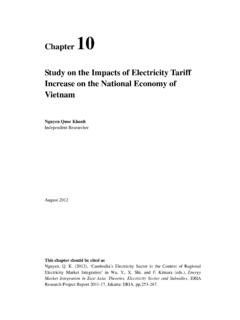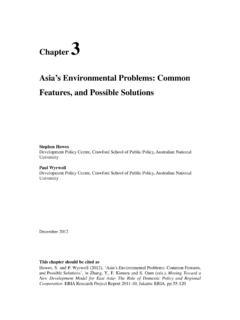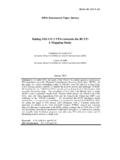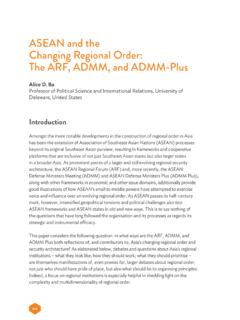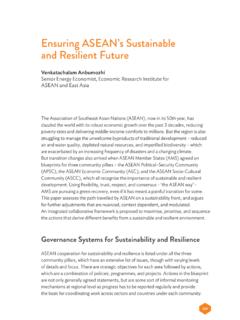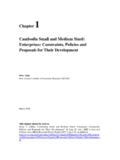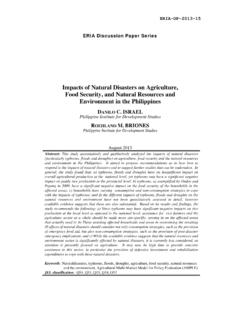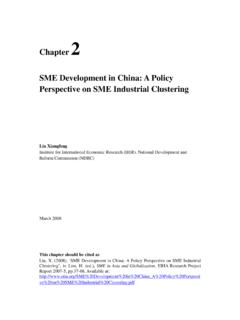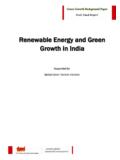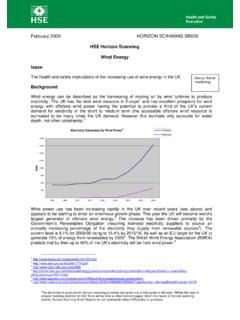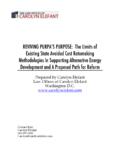Transcription of Market-Based Mechanisms to Promote Renewable …
1 ERIA-DP-2015-30 ERIA Discussion Paper Series Market-Based Mechanisms to Promote Renewable energy in Asia Venkatachalam ANBUMOZHI Economic Research Institute for ASEAN and East Asia Alex BOWEN London School of Economics and Political Sciences, UK Puthusserikunnel Devasia JOSE Indian Institute of Management Bangalore, India April 2015 Abstract: Market-Based instruments such as Renewable energy Certificate (REC) are increasingly favoured as an alternative to command-and-control legislation to increase the uptake of Renewable energy . Focusing on the Renewable energy industry and policy situation in Asia, this paper analysed the strengths and weaknesses of Market-Based approaches in the long-term interest of developing Asia.
2 It found that approaches such as REC are disadvantaged by a lack of both market acceptance and a strong institutional and programme support. To identify gaps in the REC system in India, a comparative analysis with the United Kingdom (UK) model was made. This revealed some fundamental issues around Market-Based approaches in Asia, underscoring the need for a policy design to address the concerns of buyers and sellers in the market. Keywords: Market-Based Mechanisms , Renewable energy , Renewable Obligation, Regulatory Intervention JEL Classification: Q41, Q42, Q48 1 1. Introduction Market-Based policy instruments aim to modify the behaviour of economic entities by changing the financial incentives and disincentives they face.
3 They typically operate by adjusting relative prices or creating markets that did not previously exist. A wide range of policies can be considered Market-Based , including the imposition or elimination of taxes, fees, or subsidies, and the use of energy trading systems. Market-Based policies construct systems to incorporate the costs associated with but not normally reflected in market prices, into an entity s decision-making process. Market-Based instruments are attractive alternatives to traditional command-and-control regulatory programmes, particularly for Renewable energy uptake and energy efficiency improvement. They provide firms greater flexibility to cost-effectively achieve the required Renewable energy uptake, allowing them to meet the national objectives and targets at a lower overall cost.
4 In addition, well-designed Market-Based policies can also provide greater incentive for innovation compared with command-and-control programmes. Market-Based instruments are being adopted in several parts of Asia. In India, the Renewable energy Certificate (REC) mechanism was introduced with a lot of promise for the promotion of Renewable energy in general, and wind and solar energy in particular. For energy efficiency improvements, Performance Evaluate Transfer (PET) is used as a mechanism to address inter-alia the problems of these two segments of , the problems arising from their infirm nature and constraints in terms of inter-state transfer of power from Renewable energy (RE) sources.
5 Today, however, this mechanism faces real challenges that seem to be vitiating the investment climate in RE and energy efficiency sector in general, and wind and solar segments in particular. This paper seeks to identify various issues and options that will enable Market-Based Mechanisms to facilitate large-scale RE capacity addition, particularly wind and solar, in the long run. It also seeks to review the experiences gained by other 2 countries with the tradable Renewable energy certificate system, especially the Renewable Obligation Certificate (ROC) scheme of the United Kingdom (UK). Renewable Obligation (RO) has played a major role in harnessing RE sources in the United Kingdom.
6 It has contributed effectively to widen the UK s energy and climate change goals, including Greenhouse Gas (GHG) emission reductions, de-carbonizing of the UK grid and energy security. The ROC mechanism has unique features such as banding, banking, buyout price as a penalty for non-fulfilment, inbuilt incentive mechanism for the obligated entities to fulfil their Renewable purchase obligation (RPO), secondary and forward market Mechanisms , and others. These features are not available in the current Market-Based Mechanisms in Asia. This paper therefore attempts to highlight the possible steps for an effective policy on an REC system in Asia in general and India in particular.
7 As such, a comparison has been done with the UK s ROC model so as to identify the gaps in the REC system in Asia. This has revealed some fundamental issues around the REC framework, underscoring the need for a policy design that can take care of the concerns of market players. Recommendations in terms of policy and regulatory interventions here aim to address the critical issues. 2. Types of Market-Based Policy Instruments in Asia Many countries deploy Market-Based instruments to Promote investment RE technology as well as to improve energy efficiency and combat climate change. The European Union s Emissions Trading System (ETS) is a large and well-established cap-and-trade system. In 2011, Australia introduced its own carbon pricing mechanism that will also transition to a cap-and-trade system.
8 A growing number of developing countries employ Market-Based policy instruments to reduce energy consumption as well as to jumpstart investments in clean energy are also being witnessed. For the purpose of this paper, a Market-Based policy instrument is defined as one that provides financial incentives for consumers and/or producers who are responsible for adopting RE technologies or energy efficiency improvements. 3 Policies being practiced in Asia, for that purpose fall under three broad categories: taxes, subsidies, and trading systems. Taxes set a price per unit of energy either directly on emissions or on goods or services that are carbon intensive such as coal. Meanwhile, subsidies are broadly defined as payments to encourage a particular economic action.
9 Subsidies are therefore the opposite of a tax. They include tax incentives and preferential loans. Finally, trading systems set a limit on quantities on a specific type of energy , but allow emitters to buy and sell emissions rights, letting the market determine the price rather than setting it directly as a tax does. Examples include cap-and-trade and baseline-and-credit emissions trading programmes. Trading systems may also be used to meet energy savings or RE targets. These alternative policy approaches are further defined in the glossary while Table 1 lists specific examples. Table 1: Overview of Market-Based Policy Instruments used in Emerging Economies of Asia Type of Instrument Example Subsidies Tax incentives Korea, India - Tax exemptions for biofuel Feed-in tariffs India, China - Feed-in tariffs for electricity from RE sources Preferential financing Indonesia - National Development Bank.
10 Financing for electricity production from RES and ethanol Credit guarantees Malaysia - Credit Guarantee Funds for green technologies Taxes Emission tax Japan - Tax on high CO2-emitting vehicles and electricity from non-RE Reduction or removal of high carbon taxes and subsidies Korea and India - Removal of price support for anthracite coal production Differentiated pricing China - Higher industrial electricity 4 prices for more energy -intensive enterprises Trading Systems energy efficiency and Renewable energy target- based India - energy intensity- based cap and trade for industries and tradable Renewable energy certificates Cap and trade Korea - Emission trading legislation; China - pilot emission trading systems Baseline and credit Korea - Voluntary emission reduction programme Taxes, subsides, and trading programmes have corresponding pros and cons.
